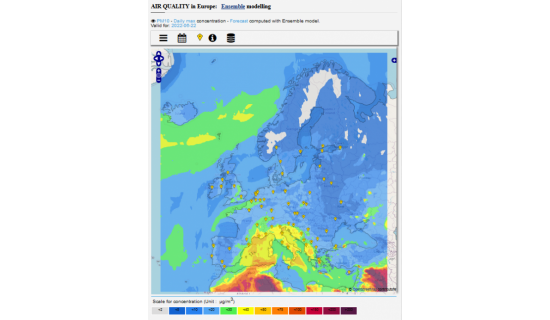Project CAMS2-40
CAMS2-40 air quality forecast
Starting from 15 June 2022, ENEA's atmospheric pollution analysis and forecasting system. MINNI, is officially part of the Copernicus Atmospheric Monitoring Service consortium (CAMS2_40), managed by the European Center for Medium-range Weather Forecasts (ECMWF) on behalf of the European Commission.
CAMS brings together the leading European teams developing numerical models for air quality. Through this consortium, regional air quality forecasts are delivered daily, and they cover the following 4 days. All the models rely on specific emissions datasets - another important product of CAMS - and are driven by ECMWF's high resolution weather forecasts. The products obtained combining the outputs of the eleven systems are delivered by Météo-France and INERIS (France) on behalf of CAMS and are available freely in the Atmosphere Data Store, together with documentation and evaluation and quality control information.
The models included in the consortium are 11: CHIMERE from INERIS (France), EMEP from MET Norway (Norway), EURAD-IM from Jülich IEK (Germany), LOTOS-EUROS from KNMI and TNO (Netherlands), MATCH from SMHI (Sweden ), MOCAGE from Meteo-France (France), SILAM from FMI (Finland), DEHM from AARHUS UNIVERSITY (Denmark), GEM-AQ from IEP-NRI (Poland), MONARCH from BSC (Spain) and MINNI from ENEA (Italy) .
The ensemble products cover a range of pollutants including those regulated in the European Union: ozone, nitrogen dioxide, sulphur dioxide, and fine particulate matter PM2.5 and PM10. The forecasts and analyses are provided on a regular grid with a resolution of about 10km by 10km over a large domain encompassing Iceland and the whole Mediterranean basin.
Beside the forecasts, models perform near-surface daily pollutant analyses with the assimilation of observations from the previous day. To this end, each member of the ensemble relies on its own data assimilation system. The observations are divided into two sets used in the data assimilation process and for the statistical evaluations of forecasts and analyses. Forecasts and analyses from all partner models are combined in the calculation of the median value of the individual outputs, which currently provides the best estimate of the ensemble (i.e. ENSEMBLE). In addition, validated and provisional reanalyses from previous years are produced with the same set of different models.
The advantage of an ensemble over a single model is that it benefits from a set of forecasts of similar general skill. The slight differences between models allows assessment of uncertainty: the more similar the individual forecasts, the lower the uncertainty. Uncertainty information is essential for CAMS users, for decision making within the agencies managing air quality in the European Union.
Using the median value of all models with as many individual forecasts above and below, at each point and timestep, CAMS could show that the ensemble European model has more skill than any of the individual forecasts on average. During the project, CAMS teams will implement a new methodology that will give different weights to the different individual forecasts based on a machine learning algorithm.
As CAMS operates under stringent time-critical conditions (daily simulations, involving significant data flows in input and output), having 11 systems means also that the possibility of receiving several individual forecasts in time becomes more likely, making the ensemble more robust. Finally, as models are developed in different countries, the ensemble benefits from a wider range of expertise that would not be available in any single country.

